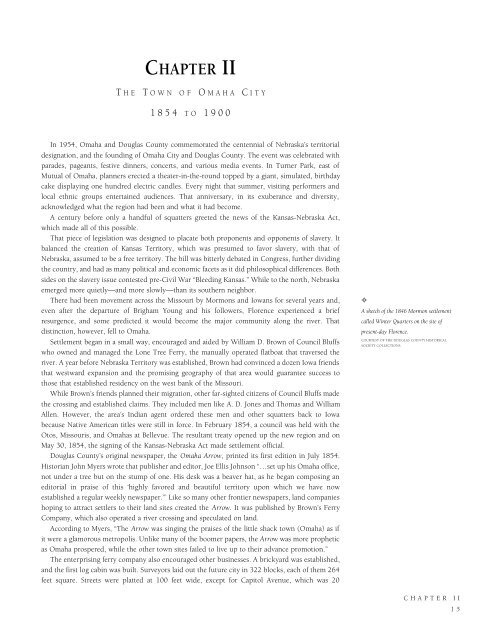Historic Omaha
An illustrated history of Omaha and the Douglas County area, paired with the histories of companies, families and organizations that make the region great.
An illustrated history of Omaha and the Douglas County area, paired with the histories of companies, families and organizations that make the region great.
Create successful ePaper yourself
Turn your PDF publications into a flip-book with our unique Google optimized e-Paper software.
CHAPTER II<br />
T HE T OWN OF O MAHA C ITY<br />
1854 TO 1900<br />
In 1954, <strong>Omaha</strong> and Douglas County commemorated the centennial of Nebraska’s territorial<br />
designation, and the founding of <strong>Omaha</strong> City and Douglas County. The event was celebrated with<br />
parades, pageants, festive dinners, concerts, and various media events. In Turner Park, east of<br />
Mutual of <strong>Omaha</strong>, planners erected a theater-in-the-round topped by a giant, simulated, birthday<br />
cake displaying one hundred electric candles. Every night that summer, visiting performers and<br />
local ethnic groups entertained audiences. That anniversary, in its exuberance and diversity,<br />
acknowledged what the region had been and what it had become.<br />
A century before only a handful of squatters greeted the news of the Kansas-Nebraska Act,<br />
which made all of this possible.<br />
That piece of legislation was designed to placate both proponents and opponents of slavery. It<br />
balanced the creation of Kansas Territory, which was presumed to favor slavery, with that of<br />
Nebraska, assumed to be a free territory. The bill was bitterly debated in Congress, further dividing<br />
the country, and had as many political and economic facets as it did philosophical differences. Both<br />
sides on the slavery issue contested pre-Civil War “Bleeding Kansas.” While to the north, Nebraska<br />
emerged more quietly—and more slowly—than its southern neighbor.<br />
There had been movement across the Missouri by Mormons and Iowans for several years and,<br />
even after the departure of Brigham Young and his followers, Florence experienced a brief<br />
resurgence, and some predicted it would become the major community along the river. That<br />
distinction, however, fell to <strong>Omaha</strong>.<br />
Settlement began in a small way, encouraged and aided by William D. Brown of Council Bluffs<br />
who owned and managed the Lone Tree Ferry, the manually operated flatboat that traversed the<br />
river. A year before Nebraska Territory was established, Brown had convinced a dozen Iowa friends<br />
that westward expansion and the promising geography of that area would guarantee success to<br />
those that established residency on the west bank of the Missouri.<br />
While Brown’s friends planned their migration, other far-sighted citizens of Council Bluffs made<br />
the crossing and established claims. They included men like A. D. Jones and Thomas and William<br />
Allen. However, the area’s Indian agent ordered these men and other squatters back to Iowa<br />
because Native American titles were still in force. In February 1854, a council was held with the<br />
Otos, Missouris, and <strong>Omaha</strong>s at Bellevue. The resultant treaty opened up the new region and on<br />
May 30, 1854, the signing of the Kansas-Nebraska Act made settlement official.<br />
Douglas County’s original newspaper, the <strong>Omaha</strong> Arrow, printed its first edition in July 1854.<br />
Historian John Myers wrote that publisher and editor, Joe Ellis Johnson “…set up his <strong>Omaha</strong> office,<br />
not under a tree but on the stump of one. His desk was a beaver hat, as he began composing an<br />
editorial in praise of this ‘highly favored and beautiful territory upon which we have now<br />
established a regular weekly newspaper.’” Like so many other frontier newspapers, land companies<br />
hoping to attract settlers to their land sites created the Arrow. It was published by Brown’s Ferry<br />
Company, which also operated a river crossing and speculated on land.<br />
According to Myers, “The Arrow was singing the praises of the little shack town (<strong>Omaha</strong>) as if<br />
it were a glamorous metropolis. Unlike many of the boomer papers, the Arrow was more prophetic<br />
as <strong>Omaha</strong> prospered, while the other town sites failed to live up to their advance promotion.”<br />
The enterprising ferry company also encouraged other businesses. A brickyard was established,<br />
and the first log cabin was built. Surveyors laid out the future city in 322 blocks, each of them 264<br />
feet square. Streets were platted at 100 feet wide, except for Capitol Avenue, which was 20<br />
✧<br />
A sketch of the 1846 Mormon settlement<br />
called Winter Quarters on the site of<br />
present-day Florence.<br />
COURTESY OF THE DOUGLAS COUNTY HISTORICAL<br />
SOCIETY COLLECTIONS.<br />
CHAPTER II<br />
15
















